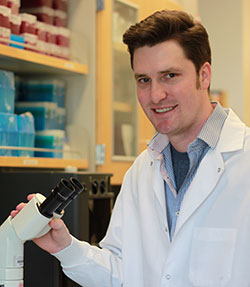Thus far, there is but a single example of a human cured of HIV: the “Berlin patient,” whose HIV was eradicated following a hematopoietic stem cell transplant (HSCT) from a donor with a rare genetic mutation (CCR5-delta 32) conferring resistance to HIV infection.
 Dr. Benjamin BurwitzBut research aimed at understanding the precise mechanisms that led to the “Berlin patient’s” cure has been hampered by the lack of adequate monkey models. Rhesus macaques, used in most non-human primate studies of HIV, are extremely diverse genetically, making it difficult to find a donor with the right types of cells.
Dr. Benjamin BurwitzBut research aimed at understanding the precise mechanisms that led to the “Berlin patient’s” cure has been hampered by the lack of adequate monkey models. Rhesus macaques, used in most non-human primate studies of HIV, are extremely diverse genetically, making it difficult to find a donor with the right types of cells.
Writing in the November issue of the journal Nature Communications, amfAR-funded scientist Dr. Benjamin Burwitz of the Oregon Health and Science University, with colleagues from there, the Oregon National Primate Research Center, and the University of Minnesota, report on a special species of monkey that can overcome this obstacle.
About 400 years ago, a group of cynomolgus macaques hit a population bottleneck: a small “founder population” was geographically isolated on the island of Mauritius in the Indian Ocean, about 1,200 miles off the southeast coast of Africa. By interbreeding, they became very restricted in terms of genetic types. Thus, transplanting cells between cynomolgus Mauritian macaques required only seven genes to be matched.
Burwitz and associates transplanted blood-forming stem cells between eight such matched monkey pairs, using cells collected from donor monkeys, in a procedure done exactly the same way as in human transplants. Preparatory procedures for transplant, including administration of immunosuppressive drugs and total body irradiation, were also similar to those used in humans. Two recipients died of transplant-related problems; this mortality rate of 25% is comparable to the 18% seen in human adult bone marrow transplants. Two recipients completely and stably engrafted (the new stem cells resumed production of healthy blood cells in their bone marrow), a fraction that is certain to improve as the technique is perfected.
The fact that many immune system and anti-HIV drugs used in humans are also effective in monkeys enhances the utility of this model. It permits standardization of antiretroviral therapy (ART), immune conditioning, multiple tissue samplings, manipulation of HIV co-receptor genes, and withdrawal of ART, procedures that ethical considerations often limit in clinical studies.
As the authors conclude, this model “will accelerate HIV cure research by facilitating a rigorous and controlled investigation of the mechanisms of post-HSCT HIV reservoir clearance.”
Dr. Laurence is amfAR’s senior scientific consultant.